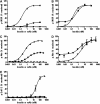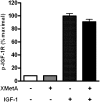A fully human, allosteric monoclonal antibody that activates the insulin receptor and improves glycemic control
- PMID: 22403294
- PMCID: PMC3331746
- DOI: 10.2337/db11-1578
A fully human, allosteric monoclonal antibody that activates the insulin receptor and improves glycemic control
Abstract
Many patients with diabetes mellitus (both type 1 and type 2) require therapy to maintain normal fasting glucose levels. To develop a novel treatment for these individuals, we used phage display technology to target the insulin receptor (INSR) complexed with insulin and identified a high affinity, allosteric, human monoclonal antibody, XMetA, which mimicked the glucoregulatory, but not the mitogenic, actions of insulin. Biophysical studies with cultured cells expressing human INSR demonstrated that XMetA acted allosterically and did not compete with insulin for binding to its receptor. XMetA was found to function as a specific partial agonist of INSR, eliciting tyrosine phosphorylation of INSR but not the IGF-IR. Although this antibody activated metabolic signaling, leading to enhanced glucose uptake, it neither activated Erk nor induced proliferation of cancer cells. In an insulin resistant, insulinopenic model of diabetes, XMetA markedly reduced elevated fasting blood glucose and normalized glucose tolerance. After 6 weeks, significant improvements in HbA(1c), dyslipidemia, and other manifestations of diabetes were observed. It is noteworthy that hypoglycemia and weight gain were not observed during these studies. These studies indicate, therefore, that allosteric monoclonal antibodies have the potential to be novel, ultra-long acting, agents for the regulation of hyperglycemia in diabetes.
Figures







Comment in
-
Selective insulin receptor modulators (SIRM): a new class of antidiabetes drugs?Diabetes. 2012 May;61(5):984-5. doi: 10.2337/db12-0192. Diabetes. 2012. PMID: 22517652 Free PMC article. No abstract available.
References
-
- 2011. 2011. Centers for Disease Control and Prevention. National diabetes fact sheet: national estimates and general information on diabetes and prediabetes in the United States, Atlanta, GA: U.S. Department of Health and Human Services, Centers for Disease Control and Prevention,
-
- Kahn CR, Flier JS, Bar RS, et al. The syndromes of insulin resistance and acanthosis nigricans. Insulin-receptor disorders in man. N Engl J Med 1976;294:739–745 - PubMed
-
- Reaven GM. Banting lecture 1988. Role of insulin resistance in human disease. Diabetes 1988;37:1595–1607 - PubMed
-
- Reaven GM. The insulin resistance syndrome. Curr Atheroscler Rep 2003;5:364–371 - PubMed
-
- Reaven G. The metabolic syndrome or the insulin resistance syndrome? Different names, different concepts, and different goals. Endocrinol Metab Clin North Am 2004;33:283–303 - PubMed
MeSH terms
Substances
LinkOut - more resources
Full Text Sources
Other Literature Sources
Medical
Miscellaneous

